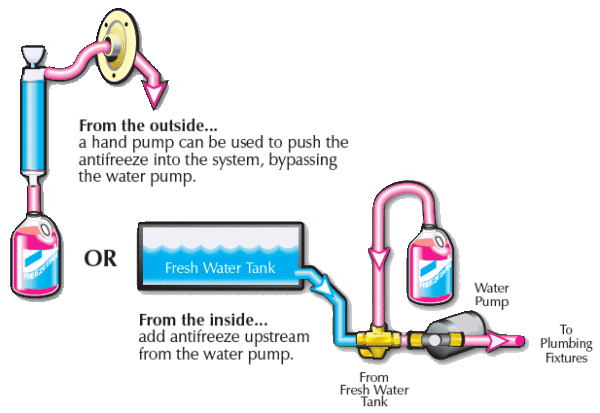As the camping season comes to a close and temperatures start to drop, one of the most important steps for RV and camper owners is preparing for winter. Freezing conditions can cause significant damage to your camper’s plumbing system, interior, and mechanical parts if left unchecked. That’s where winterizing comes in.
Knowing how to winterize a camper ensures that your recreational vehicle stays in good condition during the cold months and is ready for use when spring arrives. Whether you’re storing it in a cold garage, outdoors, or even using it for winter camping, proper winterization prevents costly repairs and prolongs the camper’s lifespan. This guide walks you through every essential step, from draining the plumbing to sealing the roof and protecting the battery.
Step 1: Drain All Water Systems to Prevent Freezing
One of the most critical parts of winterizing is clearing your camper’s plumbing system. Water expands as it freezes, and any leftover water in your pipes, tanks, or appliances can result in cracked fittings or burst pipes.
Drain the Freshwater Tank and Lines
Begin by draining the freshwater holding tank completely. Then, open all faucets, both hot and cold, and let the water drain out. Don’t forget the outdoor shower and any other hidden water outlets. Use the water pump to push out any remaining water in the lines, but be sure to turn it off as soon as the system runs dry to avoid damaging the pump.
Drain the Gray and Black Water Tanks
Next, empty the gray and black water tanks at an approved RV dump station. Once they’re empty, rinse both tanks thoroughly with a tank-cleaning wand or built-in flush system. Leaving waste inside over winter can lead to strong odors and unsanitary conditions.
Remove and Bypass the Water Heater
Turn off the water heater and let it cool down. Open the drain plug and the pressure relief valve to empty it completely. Many RVs have a bypass valve for the water heater—use it so that antifreeze doesn’t fill the heater, saving you several gallons of product.
Now that the water systems are empty, you’ve taken the first major step in learning how to winterize a camper the right way.
Step 2: Use RV Antifreeze to Protect Pipes and Fixtures
Draining removes most of the water, but small amounts can still remain in low points or bends. To protect the plumbing system completely, you’ll need to add RV-specific (non-toxic) antifreeze.
Pump Antifreeze into the System
There are two common ways to do this: through a hand pump or by using your camper’s built-in water pump via a suction line. Whichever method you choose, the goal is to circulate the antifreeze through all the lines and fixtures.
Start at the faucet farthest from the water pump. Open both hot and cold taps until bright pink antifreeze appears.
Don’t Forget Ice Makers and Washing Machines
If your camper is equipped with an ice maker, dishwasher, or washing machine, refer to the owner’s manual to properly winterize these appliances. Completing this step ensures the plumbing system is safe from cracking or bursting, which is one of the most common issues that result from improper storage. Following this correctly is a vital part of how to winterize a camper and avoid expensive repairs.
Step 3: Protect the Camper’s Interior and Appliances
Water isn’t the only threat during winter. Cold temperatures and moisture can damage interior materials, appliances, and even attract pests. Take time to prepare the inside of your camper just as thoroughly.
Clean and Defrost
Start by emptying the refrigerator and freezer completely. Defrost both units, wipe them dry, and prop the doors open to prevent mold. Remove all perishable items from the pantry, and thoroughly clean the kitchen and bathroom areas.
Vacuum the floors, check for crumbs, and wash bedding or curtains. Mice and bugs are attracted to leftover food and warmth, so it’s crucial to leave nothing behind that might invite them in.
Turn Off Appliances and Unplug Electronics
Shut off and unplug all electronic appliances to prevent phantom power drain. Turn off the main breaker, remove any batteries from smoke detectors or clocks, and consider removing the main house battery to store indoors in a dry place.
For propane systems, shut off the gas supply and ensure all valves are sealed tightly. If you plan to store the camper for months, consider disconnecting and capping the propane lines for extra security.
Step 4: Secure the Exterior and Roof from the Elements
The exterior of your camper faces harsh weather directly, so it needs equal attention. Snow, ice, and even UV rays can cause degradation if left unchecked.
Inspect and Seal Openings
Check all windows, doors, roof seams, and vents for cracks or openings. Use weatherproof RV sealant to close any gaps and prevent leaks. Water intrusion during winter can rot wood and damage insulation.
If your camper has a slide-out, retract it fully and inspect the seals. Clean off any debris or buildup from the rubber seals and apply protectant if needed.
Cover and Ventilate
Use a breathable camper cover made for winter storage to protect from snow, rain, and UV light. Avoid using tarps that trap moisture. Cover the tires with UV shields to prevent dry rot, and use wheel chocks to stabilize the camper.
Keep roof vents slightly open using vent covers to allow airflow and reduce condensation buildup inside. Moisture control is critical in preventing mold growth.
Properly preparing the exterior is your camper’s first defense against winter weather and an essential part of how to winterize a camper safely and effectively.
Step 5: Final Storage Preparation and Maintenance Checklist
Now that your camper is winterized, store it in a safe location. Whether it’s a driveway, storage lot, or indoor garage, some final steps help maintain your RV during its dormant period.
Choose a Storage Location Wisely
If storing outdoors, make sure the ground is level and dry. Avoid parking under trees that can drop branches or sap. For indoor storage, ensure there’s good ventilation and protection from temperature extremes.
Battery and Tire Care
If you’ve removed the batteries, check their charge monthly and store them in a cool, dry place. For tires, inflate them to the recommended pressure and consider moving the camper slightly every month to prevent flat spots.
Create a Maintenance Schedule
Even during storage, your camper needs some attention. Check it monthly for leaks, pest activity, or moisture. Run a dehumidifier or moisture absorber inside to maintain dryness. Doing small maintenance checks throughout winter prevents small issues from becoming major problems.
Winterization isn’t just a one-day job—it’s a season-long mindset of care and preparation.
Conclusion: Ready for a Trouble-Free Spring
By following these detailed steps, you’ve learned how to winterize a camper thoroughly. Draining and protecting the plumbing, securing the interior and exterior, and storing your vehicle with care all ensure that when the next camping season rolls around, your camper will be ready to go with minimal effort.
Many RV owners skip one or two small steps, only to find costly damage in spring. Don’t let that be you. Winterizing may take a day of your time, but it saves days of frustration and hundreds, even thousands, of dollars in repairs.
When the warm weather returns, you’ll appreciate that your camper is just as clean, safe, and operational as the day you stored it. So take the time now to protect your investment by properly understanding and applying the knowledge of how to winterize a camper — your future self will thank you.







